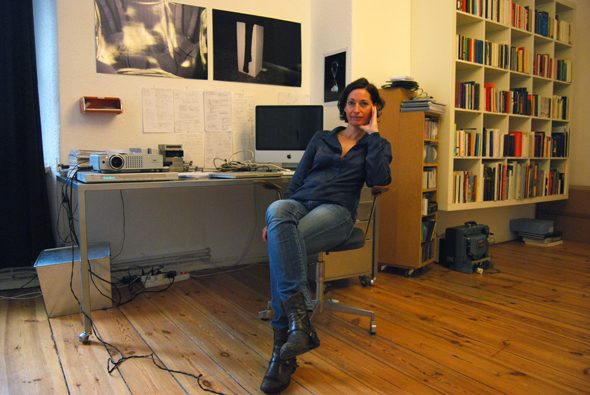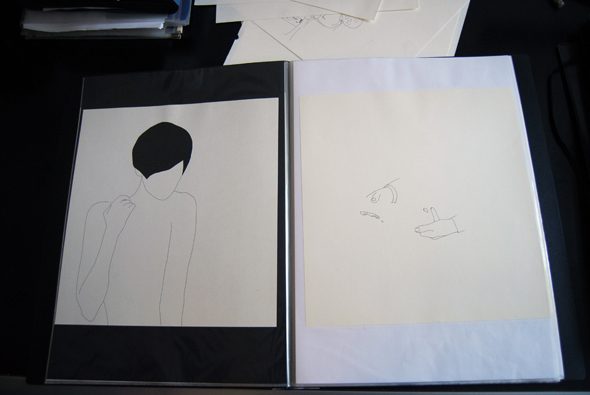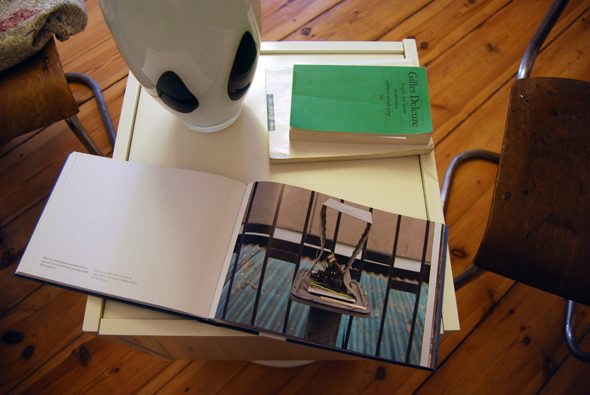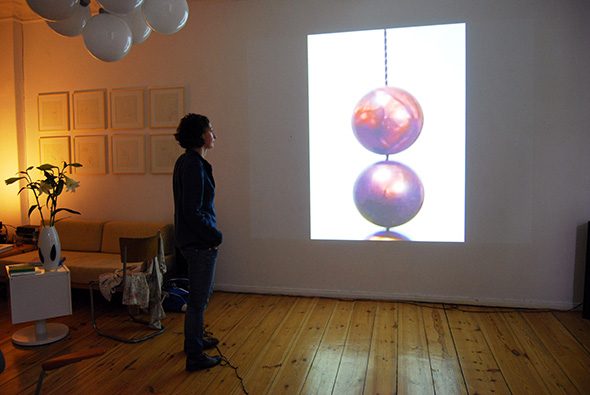by Devon Caranicas // Oct. 31, 2011
At first glance, Christine de la Garenne’s stylish living room with a low slung beige couch, white modern chandelier and detailed antique molding seems void of the traditional messy markings one would associate with a studio. Such is the luxury of a video artist and photographer whose practice has mitigated into the realm of the digital; a compact medium that leaves little discernible trace in comparison to her painter or sculptor peers. Aside from the large overflowing book case it seems that Christine’s work is limited to the two metal desks that sit tucked into the far right corner of the room. On one sits the essential multiple Mac computers, a projector and an array of post-it notes.

We drink yogi tea on the couch and begin by discussing her routine (she often works at night), some of her past art travels (Los Angeles, China and France) and her current shows (most notably, this year’s Venice Biennale). Christine is sensitive in the most literal sense of the word. Meaning, and as defined by the dictionary, she is quick to detect or respond to slight changes. As our conversation changes from formal to friendly it is obvious that Christine’s innate senses are hyper in-tune with the subtleties of her surroundings. She likes the sounds cans make when they blow against pavement, she keeps flowers in the studio because of their subtle fragrance, she adores the empty forgotten places in Berlin’s unique urban abandonment and carries her camera with her at all times to photograph the peculiar and the beautiful. This attentive gene that she possesses has translated to, if not defined, her practice. We look at a book she co-created with fellow artist Via Lewandowsky at a residency in Beijing. For 120 days the two photographed a daily anomaly. From an atypical food package to an odd sign, the images are arranged chronologically. The book, published by Hatje Cantz and titled Neobiota. Fragments of misunderstanding, shows an unfolding pictorial evolution of a foreigner’s interpretation and absorption of a radically contrasting culture.

When it comes to Christine’s videos this scrutiny yields works that are neither narrative nor abstract, per se. Some have a magnified perspective, such as ON–DIT (2005), that we watched projected on the massive white wall across from her desk. This macro viewpoint dissolves the visual into a conceptual image based heavily on its pictorial representation. However, ON-DIT‘s main focus is the overt rhythmic dropping of the prayer beads. The brown pearly orbs, a symbol in both Christianity and Islam, crash together, bounce and crash again bringing to mind the duality and co-existence of meditation and conflict. The acoustics of Christine’s work sometimes create a bizarre disjointed audio/visual combination. Often produced separately from the video work (and thereby not quite matching) or enhanced and manipulated, as they are in ON-DIT, the sounds don’t just reinforce a visual point – they become the second actor in the scene.

Themes that run though Christine’s body of work are the universal, the sublime and the surreal. Time, timelessness, and the inability to comprehend either is the subject of one of her more recent works AEON (2011). In this piece a white sand-filled hourglass is presented continuously running on a black background. Draining from top to bottom and in reverse- the sand never fully reaches full or empty. The movement accentuates a passing of time while AEON retains an infinite moment of present generated by the controlled image lacking a beginning or end.
This looping property is evident in all of De la Garenne’s work because, as she explains, she wants the video installations to “work like a picture or a painting.” By creating a constant visual there is no start or finish, thus removing any sense of a chronological marking. This tactic begs the viewer to become as in touch with the subtleties of her work as Christine is – an easy feat when the frames are as beautifully composed and visually mesmerizing as hers.
The second desk in Christine’s studio corner is used as a drawing table. The minutia that accompanies editing can, as Christine explains, at times leave her feeling cold. In order to balance the tedious single-frame manipulation that she works with, drawing allows for immediate gratification and tangible results. Although visually quite different from the digital work, the methodical nature and precision of her artistic process is still apparent. Christine begins with a rough, usually figurative, sketch and slowly subtracts visual information with ever subsequent drawing. Each time Christine redraws the image she edits out content and lines the way a writer would pare down superfluous language. The final product is a situationally ambiguous but skillfully meticulous line drawing. She explains that “The less I say, the more open it becomes,” a sentiment that exists at the very essence of Christine’s process.

“Christine de la Garenne hat einen Korpus von Videoarbeiten geschaffen, in dem sie die Grenze befragt, an der sich die Begriffe Realität, Projektion und Repräsentation artikulieren und durchdringen. Sie schöpft aus dem Realen a priori unstrittiger Referenten, vergrößert sie, verzerrt und deformiert sie durch die Effekte der Kamera und des Digitalen.
Da wo Walter Benjamin in der Kamera (durch Zeitlupe und Großaufnahme) einen Operator des Realen sah, gebraucht Christine de la Garenne diese Mittel, um Realität in Frage zu stellen und aus dem Zweifel das Prinzip unserer Beziehung zu den Bildern zu machen. Durch die Bearbeitung des Tons und den Gebrauch der dem Video eigenen Loop- Effekte gelingt es ihr, den Sinn, der den Bildern zugeschrieben ist, zu entfremden. Sie deckt die den Bildern innewohnenden Klischees auf.
Diese Bilder unterliegen keinem referenziellen Prinzip mehr. Christine de la Garenne verweist den Betrachter letztlich auf ihn selbst und reduziert das Videobild auf sein Wesentliches, d.h. einen Projektionsraum, in dem die Luftspiegelung das metaphorische Prinzip unserer Beziehung zur Welt ist. Das was Sie sehen ist nicht das, was Sie sehen,sondern das, was Sie projizieren.” (Cédric Aurelle, 2007)

























